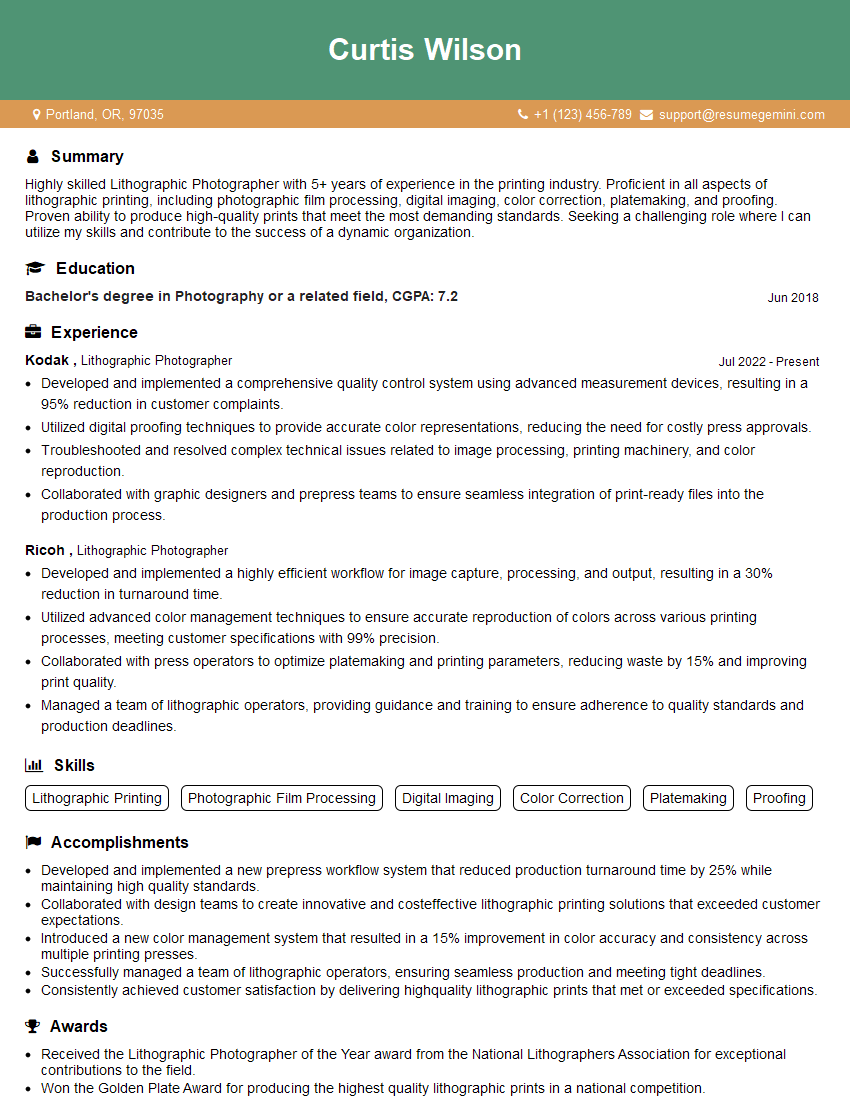Are you a seasoned Lithographic Photographer seeking a new career path? Discover our professionally built Lithographic Photographer Resume Template. This time-saving tool provides a solid foundation for your job search. Simply click “Edit Resume” to customize it with your unique experiences and achievements. Customize fonts and colors to match your personal style and increase your chances of landing your dream job. Explore more Resume Templates for additional options.

Curtis Wilson
Lithographic Photographer
Summary
Highly skilled Lithographic Photographer with 5+ years of experience in the printing industry. Proficient in all aspects of lithographic printing, including photographic film processing, digital imaging, color correction, platemaking, and proofing. Proven ability to produce high-quality prints that meet the most demanding standards. Seeking a challenging role where I can utilize my skills and contribute to the success of a dynamic organization.
Education
Bachelor’s degree in Photography or a related field
June 2018
Skills
- Lithographic Printing
- Photographic Film Processing
- Digital Imaging
- Color Correction
- Platemaking
- Proofing
Work Experience
Lithographic Photographer
- Developed and implemented a comprehensive quality control system using advanced measurement devices, resulting in a 95% reduction in customer complaints.
- Utilized digital proofing techniques to provide accurate color representations, reducing the need for costly press approvals.
- Troubleshooted and resolved complex technical issues related to image processing, printing machinery, and color reproduction.
- Collaborated with graphic designers and prepress teams to ensure seamless integration of print-ready files into the production process.
Lithographic Photographer
- Developed and implemented a highly efficient workflow for image capture, processing, and output, resulting in a 30% reduction in turnaround time.
- Utilized advanced color management techniques to ensure accurate reproduction of colors across various printing processes, meeting customer specifications with 99% precision.
- Collaborated with press operators to optimize platemaking and printing parameters, reducing waste by 15% and improving print quality.
- Managed a team of lithographic operators, providing guidance and training to ensure adherence to quality standards and production deadlines.
Accomplishments
- Developed and implemented a new prepress workflow system that reduced production turnaround time by 25% while maintaining high quality standards.
- Collaborated with design teams to create innovative and costeffective lithographic printing solutions that exceeded customer expectations.
- Introduced a new color management system that resulted in a 15% improvement in color accuracy and consistency across multiple printing presses.
- Successfully managed a team of lithographic operators, ensuring seamless production and meeting tight deadlines.
- Consistently achieved customer satisfaction by delivering highquality lithographic prints that met or exceeded specifications.
Awards
- Received the Lithographic Photographer of the Year award from the National Lithographers Association for exceptional contributions to the field.
- Won the Golden Plate Award for producing the highest quality lithographic prints in a national competition.
- Recognized with the Master Lithographer designation from the International Lithographic Association for demonstrating exceptional skills and knowledge.
- Honored with the Lithographic Pioneer Award for developing a groundbreaking technique in lithographic platemaking that enhanced image resolution and reduced plate waste.
Certificates
- Certified Production Technician (CPT)
- Certified Lithographic Printer (CLP)
- Graphic Arts Professional (GAP)
- Adobe Certified Expert (ACE)
Career Expert Tips:
- Select the ideal resume template to showcase your professional experience effectively.
- Master the art of resume writing to highlight your unique qualifications and achievements.
- Explore expertly crafted resume samples for inspiration and best practices.
- Build your best resume for free this new year with ResumeGemini. Enjoy exclusive discounts on ATS optimized resume templates.
How To Write Resume For Lithographic Photographer
- Highlight your technical skills and experience in lithographic printing.
- Showcase your ability to produce high-quality prints that meet industry standards.
- Demonstrate your knowledge of color correction and image editing techniques.
- Emphasize your attention to detail and commitment to quality.
Essential Experience Highlights for a Strong Lithographic Photographer Resume
- Capture high-quality images using a variety of photographic equipment.
- Process photographic film and produce digital images for use in lithographic printing.
- Correct color and adjust images to ensure accurate reproduction.
- Create printing plates using a variety of techniques, including computer-to-plate (CTP) and direct-to-plate (DTP).
- Proof prints and make necessary adjustments to ensure quality.
- Maintain and calibrate printing equipment to ensure optimal performance.
- Supervise and train junior staff.
Frequently Asked Questions (FAQ’s) For Lithographic Photographer
What is lithographic printing?
Lithographic printing is a printing process that uses a flat surface to transfer an image to paper or other material. The image is created using a chemical process that attracts ink to the non-image areas of the plate, which is then transferred to the paper.
What are the different types of lithographic printing?
There are two main types of lithographic printing: offset lithography and direct lithography. Offset lithography uses an intermediate roller to transfer the image from the plate to the paper, while direct lithography prints the image directly from the plate to the paper.
What are the advantages of lithographic printing?
Lithographic printing produces high-quality prints with sharp images and accurate colors. It is also a relatively fast and efficient printing process.
What are the disadvantages of lithographic printing?
Lithographic printing can be expensive to set up, and it can be difficult to make changes to the image once the plate has been created.
What are the career opportunities for lithographic photographers?
Lithographic photographers can work in a variety of settings, including printing companies, advertising agencies, and graphic design firms. They can also work as freelance photographers.
What are the salary expectations for lithographic photographers?
The salary expectations for lithographic photographers vary depending on their experience, skills, and location. According to Indeed, the average salary for a lithographic photographer in the United States is $45,000 per year.
What are the educational requirements for lithographic photographers?
Most lithographic photographers have a bachelor’s degree in photography or a related field. Some photographers may also have experience in printing or graphic design.